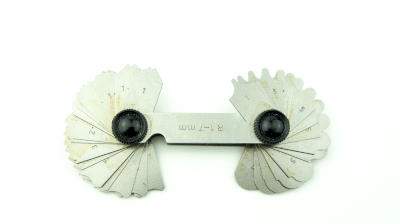What Is a Radius Gauge?

A radius gauge is an inspection tool used to check the roundness or corner radius (R) of a workpiece. It involves placing the gauge‘s radius tip against the workpiece to visually inspect if the standard radius dimensions are met. Unlike contour measuring machines that provide measured values, radius gauges offer a quicker and more cost-effective solution for checking radius dimensions, though they do not output measurement values.
Uses of Radius Gauges
Radius gauges are particularly useful for:
- Checking the corner radius of workpieces in machining processes.
- Verifying if specified radius surfaces on shafts or joints meet the required standards in turning processes.
- Inspecting radius dimensions in complex structures or installed pipes, where movement of the workpiece is restricted.
Principle of Radius Gauges
Radius gauges consist of thin plates with a pre-defined radius profile (convex or concave) at one end, with the relevant dimensions indicated on the plate. They are used by aligning the radius along the measurement section of the workpiece.
To confirm conformity between the gauge and the workpiece, materials like blue paste may be used, although results can vary based on the application of the paste and the need to remove it post-inspection. Regular checks for wear and deformation of the gauges are necessary, especially when using blue paste as it accelerates wear.
While contour gauges provide accurate measurements, radius gauges are simple and easy to use. The choice between the two depends on the specific results needed.